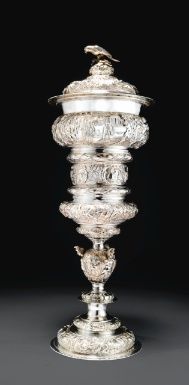Coupe couverte en argent, poinçon de maître IS, Leszno (Lissa), vers 1690
Coupe couverte en argent, poinçon de maître IS, Leszno (Lissa), vers 1690 - Photo Sotheby's
finement ciselée de scènes relatant le commerce et le tissage de la laine, de l'histoire de Pyrame et Thisbé, de paysages urbains et ruraux, de putti jouant des instruments, d'animaux, insectes et fruits. Haut. 50 cm, 1483 g. Estimation: 18,000 - 22,000 EU
A POLISH SILVER CUP AND COVER, MAKER'S MARK IS CONJOINED, LESZNO (LISSA), CIRCA 1690
elaborately chased with scenes from the wool and weaving trade, scenes from the story of Piramus and Thisbe, city and country scapes, musical putti, seasprites, animals insects and fruit, marked on body and cover; 20in, 47oz 12dwt
NOTE DE CATALOGUE: Le poinçon de maître sur cette coupe, le monogramme IS, est probablement le même que celui retrouvé sur certaines pièces d'argenterie datant de 1689-1694, publié par le musée drukarmi, voir Przemysl zlotniczy w polsce, Krakow,vers 1920.
Le tissage et commerce de la laine, illustrés sur cette coupe, étaient essentiels pour l'économie de Leszno au XVIIe siècle. Initiée grâce à l'arrivée d'un groupe de tisserands luthériens de Silésie au XVIe siècle, l'industrie de la laine était tellement importante au XVIIe siècle que les anglais ala considéraient comme une menace potentielle. Un rapport anglais de 1651 mentionne ainsi que la "prodigieuse" industrie de Leszno produçait 220,000 habits et 150,000 rashes par an", voir Eric Kerridge, Textile manufacture in early modern England, Manchester, 1985, p. 32 (un rash était une sorte d'habit fait de soie, ou bien de laine peignée ou bien des deux, Webster's New Internation Dictionary, Northampton, Mass., 1934).
The cup's maker IS in monogram is probably the monogrammist IS recorded in Przemysl zlotniczy w polsce, published by the drukarni muzeum przemyslowego, Krakow, circa 1920, no. 151 p. 207, found on silver made between 1689-1694.
The wool and weaving trade, images of which are prominently shown on this cup, were central to Leszno's economy in the 17th century. One of the key groups of early settlers were the Lutheran cloth workers of Silesia who came there in the 16th century. By the mid 17th century the clothing industry in Leszno was so important that it was seen as a threat by the English. An English report of 1651 records the `prodigious' industry of ...Leszno `producing 220,000 ordinary cloths and 150,000 rashes a year'. See: Eric Kerridge, Textile manufacture in early modern England, Manchester, 1985, p. 32 (A rash was a superior type of cloth made of silk, or worsted or a mixture of the two Webster's New Internation Dictionary, Northampton, Mass., 1934).
Sotheby's. Orfèvrerie Européenne, Boîtes en Or et Objets de Vitrine. Paris | 08 nov. 2012 www.sothebys.com

/https%3A%2F%2Fprofilepics.canalblog.com%2Fprofilepics%2F1%2F0%2F100183.jpg)
/https%3A%2F%2Fstorage.canalblog.com%2F03%2F02%2F119589%2F96711876_o.jpg)
/https%3A%2F%2Fstorage.canalblog.com%2F11%2F31%2F119589%2F94773502_o.jpg)
/https%3A%2F%2Fstorage.canalblog.com%2F20%2F83%2F119589%2F94772815_o.jpg)
/https%3A%2F%2Fstorage.canalblog.com%2F26%2F72%2F119589%2F75604929_o.jpg)
/https%3A%2F%2Fstorage.canalblog.com%2F59%2F60%2F119589%2F26458628_o.jpg)



/http%3A%2F%2Fstorage.canalblog.com%2F24%2F40%2F119589%2F121031438_o.jpg)
/http%3A%2F%2Fstorage.canalblog.com%2F97%2F39%2F119589%2F110438637_o.jpg)
/http%3A%2F%2Fstorage.canalblog.com%2F18%2F36%2F119589%2F110437798_o.jpg)
/http%3A%2F%2Fstorage.canalblog.com%2F89%2F36%2F119589%2F110438050_o.jpg)